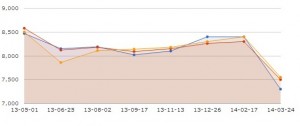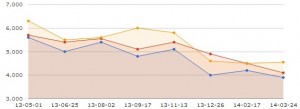According to the Daily NK:
Rice prices in North Korea remain stable despite the arrival of the April-May “spring hardship period,” inside sources have conveyed to Daily NK.
Spring months are usually tough because food supplies run low as North Korea, with its relatively low level of external trade in foodstuffs, waits for the early domestic potato harvest at the end of June. This in turn impacts market rice prices; in May 2012, the price of a kilo of rice skyrocketed by 20% in a single month.
However, this year has been a good one. Sources convey that a kilo of rice is trading in Pyongyang, Sinuiju and Hyesan for 3700, 3850 and 3900 won respectively. This is consistent with preceding months, and below the 4000 won mark initially recorded last December.
The price of corn, often used as a cheap substitute by low-income households when rice gets expensive, is also showing a stable or downward trend. At 800-1000 won per kilo, it is 500 won less than it was in April.
Several factors are contributing to this relative stability, a Hyesan source contended. Firstly, work units on cooperative farms are bringing their stores of rice to market in bulk payment for resources for the planting season. Secondly, May has seen a small decrease in the exchange rate, and this has helped to keep the rice price down in terms of imports.
“It’s the spring planting season and work units have to purchase resources like diesel and fertilizer. People say that ‘rice is money,’ and now they’re selling rice they had stored from last year to purchasing farming products. This means there is enough rice in the markets and the price is stable,” the source said.
A Pyongyang-based source also reported stable market prices, as well as consistent state ration delivery in April.
“The authorities have been continually distributing rations and there is sufficient rice in the markets. More people are buying meat including pork because some laborers had a wage increase. The rice price could drop even further,” he assessed.
Nevertheless, experts in Seoul assert that rice prices could be negatively affected by current dry conditions in the country’s western breadbasket zones
Cho Bong Hyun of the IBK Economic Research Institute clarified to Daily NK, “The recent price stability in North Korea’s markets is because of continuous distribution since the release of military rice reserves last year. Expectations around this year’s output could also impact prices further down the line. Some will plan to store rice if they anticipate this year being a lean one, which will in turn drive up the rice price.”
Read the full story here:
Market Prices Stable Despite Lean Period
Daily NK
Lee Sang Yong
2014-05-16


